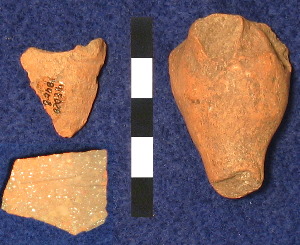Instrumental Neutron Activation Analysis
Instrumental neutron activation analysis (INAA) can provide valuable insights into the behaviors of peoples of the past. By examining the chemical composition of stone tools and pottery, we can often identify sources of the raw material. Even these small pieces of information help us interpret resource-gathering practices among native groups and provide clues as to where people may have been before coming to the site. When combined with data from other sites, this type of information provides a broader picture of hunter-gatherer mobility patterns and procurement strategies.
All natural materials are composed of a series of chemical elements and compounds that are traceable. Rocks and clays derived from a certain location will have a similar chemical make-up to other materials form the same location. INAA is used on rocks and fired/unfired clays to acquire an elemental signature, or chemical fingerprint, of that sample to be compared to known source samples.
Methods: Ceramic Samples
Eighteen plainware ceramic sherd samples and one local matrix sample were submitted to the University of Missouri Research Reactor (MURR) Laboratory for analysis. These included three non-bone tempered sherds from the historic Mission San Lorenzo (41RE1) in Camp Wood, five bone tempered sherds from the historic Mission San Juan (41BX5) in San Antonio, and ten mostly bone tempered sherds from the Toyah component at the Varga site. The ten samples from Varga represent possibly five vessel groups. The matrix sample was a dark gray silty loam Bk soil at 65 to 70 cmbs and part of geomorphic Unit 3 from BT 2 at the Varga site. This local alluvial sediment was used for comparison to assess the presence of locally made pottery versus pots of made non-locally.
The following information on ceramic analysis concerning the methods and interpretations of results is excerped from a report by Speakman and Glascock (2000). Fragments of about 1 cm2 were removed from each sample and abraded using a silicon carbide burr in order to remove glaze, slip, paint, and adhering soil, thereby reducing the risk of measuring contamination. The samples were washed in deionized water and allowed to dry in the laboratory. Once dry, the individual sherds were ground to powder in an agate mortar to homogenize the samples. Archival samples were retained from each sherd (when possible) for future research. Clay samples were fired in a furnace to 700° Celsius for one hour. Portions of approximately 150 mg of powder were weighed into small polyvials used for short irradiations. At the same time, 200 mg of each sample was weighed into the high-purity quartz vials used for long irradiations. Along with the unknown samples, reference standards of coal fly ash and basalt rock were similarly prepared, as were quality control samples (e.g., standards treated as unknowns) of obsidian rock and Ohio Red Clay. Read more
Findings: Ceramics
All samples have less than four percent probability of membership in the sample of roughly 200 tested sherds that represent the Central Texas-1 and 2 ceramic compositional groups. What is apparent in two plots is that most of the analyzed samples fall outside of the 90 percent confidence ellipses calculated for the three previously analyzed reference groups. A bivariate plot of thorium and sodium base-10 logged data likewise suggests that most of the samples cannot be firmly associated with the Central Texas reference groups. Based on the Mahalanobis distance calculations and visual inspection of the data, we conclude that 18 of the samples do not belong to the Central Texas reference groups.
There is clear chemical patterning in the remaining Toyah specimens. Pottery from Varga forms two separate and chemically distinct groups. The INAA data indicates that, at a minimum, two vessels represented in Vessel Groups 2 and 4 were manufactured using local clay sources. The five Mission San Juan sherds are chemically separate and distinct from the three Mission San Lorenzo sherds. The INAA appears to be separating different clay sources/manufacturing localities for these various sherds and vessels. These findings all combine to indicate that native ceramic production in the central Texas Late Prehistoric involved widely shared technological procedures that were carried out largely within the localized operational areas around specific occupation sites.
The INAA of a unique figurine-like clay object indicates this piece is chemically distinct from the two identified Varga compositional groups (Varga-1 and Varga-2), and the Central Texas 1 and 2 reference groups. This object is also chemically distinct from the local sediment sample, which means it was most likely manufactured from non-local clays. Apparently this was a trade item, brought into the site as a finished piece. Where it was manufactured is not known at this time.
Because the two Varga groups are represented by so few samples, any attempt to statistically validate these groups would be purely subjective. Despite the limitations with sample size, the INAA data suggest that analysis of additional pottery from these sites would result in identification of several chemically distinct reference groups. Establishing a database for these samples could ultimately aid in assessing Late Prehistoric pottery movement among these sites.
Methods: Chert Samples
INAA was performed on 154 chert artifacts from the four major time periods represented at the Varga Site. This included 107 natural (i.e., culturally unmodified) specimens from various locations in the Edwards Formation across southwest and central Texas. Chemical data from natural rocks were examined for possible differences within the Edwards Formation. Chemical data from the artifacts were examined to calculate probabilities of membership with the various Edwards Formation chert sub-types. INAA data from previously analyzed samples of Edwards Formation chert from the Texas Hill Country conducted for Charles Frederick (i.e., Fort Hood) and Chris Turnbull (i.e., Segovia Formation) were also used for comparison.
The MURR laboratory analysis documents the chemical fingerprint of a material and provides data that researchers can use to differentiate sourcing and composition characteristics. The following information is taken from Speakman and Glascock (2008). The procedures follow those discussed above in the ceramic section.
Findings: Natural Chert
The new raw source samples submitted show very subtle differences between most of the previous natural collection sites. This is principally due to the fact that compositional variation within individual outcrops is large and chemical differences among outcrops are relatively small. Examination of these plots reveals that the smaller natural groups from Hackberry Creek, Glen Rose, Georgetown, Varga mixture, and Devils River Formation show differences. The vectors shown on the plots indicate the contributions of individual elements explain the differences between the groups. Comparisons between the new rock samples and previously analyzed rocks indicate that the new samples are significantly different from the six varieties of chert collected near Fort Hood, but they overlap with an earlier collection of natural Edwards Formation chert from throughout the formation.
Findings: Chert Arifacts
Analyses of the Varga site artifacts reveal that they are compositionally different from the multiple Fort Hood varieties. However, the Varga site artifacts are similar to both of the natural collections of Edwards Formation source specimens. Our primary conclusion is that none of the Varga site artifacts came from Fort Hood or Howard County sources. We can say little about other outcrops within the Edwards Formation.
The INAA on a broad suite of 47 Toyah phase tools indicate that the raw materials used in their manufacture have chemical signatures that are similar to Edwards cherts, probably from the local southwestern outcrops of Edwards chert. Judging from the bivariate plots of principal components 1 and 2, no lithic materials originated in western Edwards County or in Val Verde County. Several pieces have chemical signatures similar to Edwards chert from Kerr County. A few pieces have signatures similar to chert gravels from the Nueces River bed near Camp Wood in southern Edwards County. The Cuney type point yielded a chemical signature similar to Edwards chert found in the vicinity of the headwaters of Hackberry Creek near 41ED58. This implies that although the Cuney point type is most often found in more northeastern counties of Texas, this particular specimen was probably manufactured from local materials.
The INAA on natural and cultural cherts provides a greater understanding of the procurement territory of the populations in question and the distance the materials may have been transported. Continued use of INAA on ceramic sherds and tool stone will help to define where and how far these mobile groups may have moved, and to establish the group’s procurement territory.
Neutron Activation Analysis addresses such questions as:
|
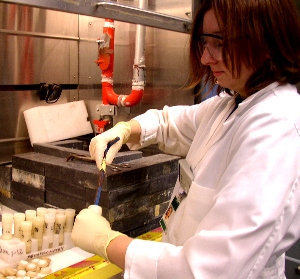
|
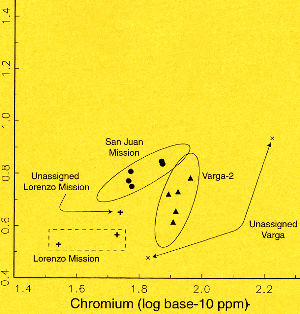
|
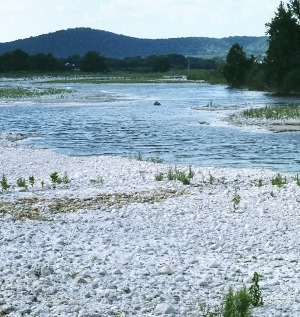
|
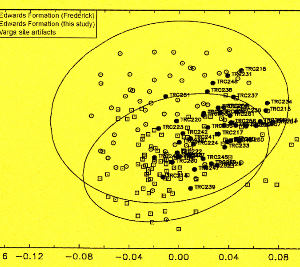
|

